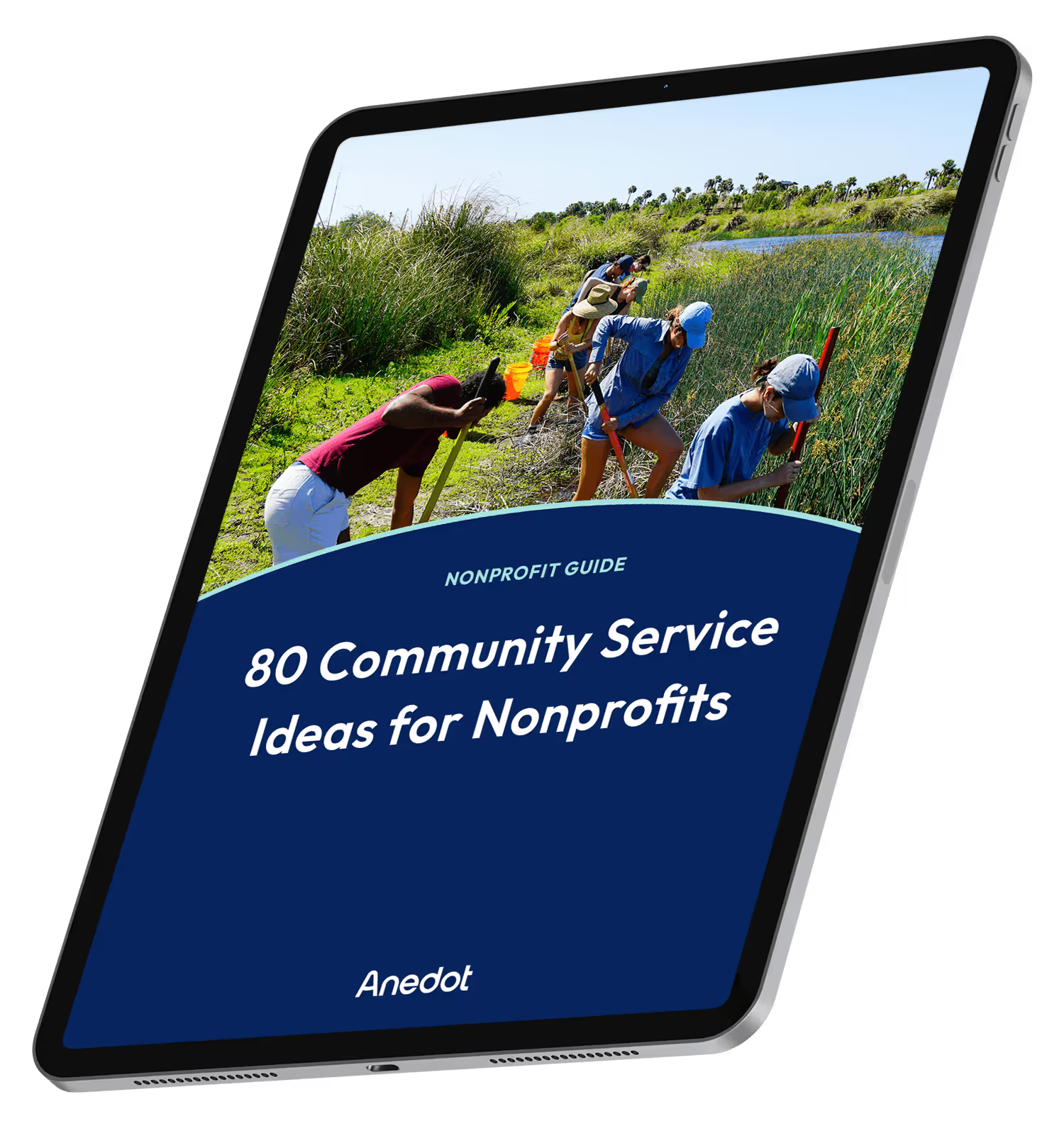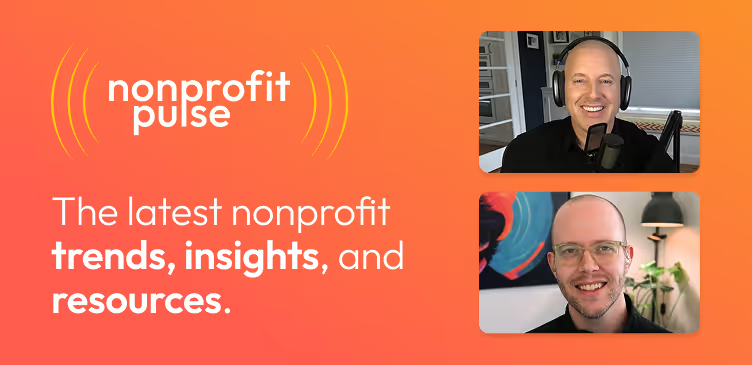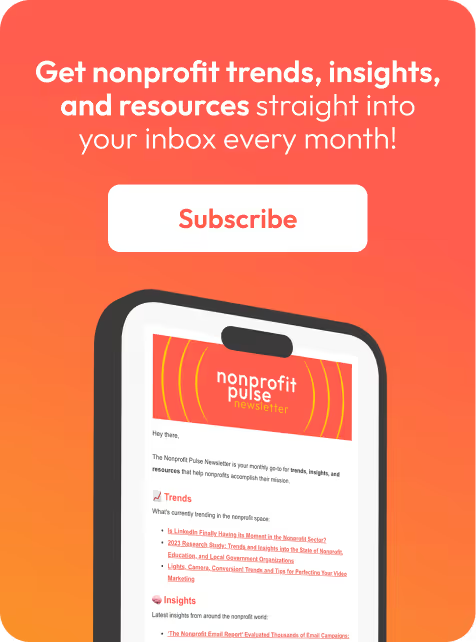Podcast episode transcript ↓
Josh:
Welcome to Big Ideas For Every Org. We help leaders discover powerful, big ideas that increase organizational impact.
I'm Josh, and today we're joined by Chris Williams.
Chris is a 40-year veteran of the technology industry, a former Microsoft vice president, and now a leadership advisor.
On this episode, we are talking about having a clear vision for your organization. Providing clarity on anything is hard work, providing clarity on organizational vision is even harder.
But when teams and leaders are aligned with clarity and unity, your supporters are served better and your teams move forward more engaged and fulfilled.
Having a clear organizational vision is a powerful tool to help you and your organization grow together and succeed. Chris, thanks for joining us.
Chris:
Good to be here, Josh. Nice to talk to you.
Josh:
Hey, so before we jump into the topic today, will you tell us a bit about yourself and your organization?
Chris:
Yeah. I am, as you noted, a 40-year veteran of the technology industry, I started out writing code a long time ago, but throughout my entire career, I have had a fascination with organizations and leadership and how organizations work.
I was very fortunate to get to Microsoft at the peak of their growth in the '90s and managed to get myself into a couple of really interesting positions that allowed me a chance to see how organizations work and how projects work and what makes them work and not work.
Eventually, I became vice president of HR for the whole company. That gave me just an incredible perspective across the entire organization.
I've used that ever since, I've been consulting with small businesses, with startups, with nonprofits and a wide range of executives, helping them to understand how to do a better job of building and leading great teams.
Josh:
Yeah. So, I discovered you on TikTok and we were just talking about some of the metrics there.
In just eight weeks, you have amassed almost 70,000 followers, almost half a million likes and around 7 million plays all within eight weeks of joining that platform with your leadership content, which is incredible.
And I know that I account for many, many likes and plays in your metrics there, but just, man, congrats on that. Those are huge numbers.
Chris:
Well, it's really interesting, Josh, because TikTok has this terrible reputation for being the kids dancing app.
That's really not at all what it has grown into being. It's got a deep, rich political side to it. It's got obviously all kinds of influencers and people talking about products and health and any number of things.
But it also has a rich business community. So, there's a lot of people doing a lot of good things, talking about how to interview for jobs and that sort of thing. My notice of it was that the leadership advice was a little thin, that it tended to be people who had done a lot of reading about leadership, but not a lot of people who had done a lot of leadership.
So, I thought there was a real opportunity there and TikTok has shown me to be right, that I'm getting an incredible amount of positive feedback to the stuff I've been doing. A lot of it is, "Oh man, it's so great to see somebody who's got deep, rich experience in building and leading teams giving advice on how to do that."
Josh:
Yes, absolutely. That's that's why I followed you and love your content. It's just so helpful.
The problems associated with the lack of a clear organizational vision

Josh:
So, before we talk about the solution to the problem of a vision and a lack of vision, just tell us, how did you begin to see problems associated with the lack of vision?
Chris:
Well, that's a fascinating story. So, what happened was I had worked at Microsoft for a number of years, had managed a wide variety of teams.
At one point, was promoted to be the director of software development across the entire company. What that meant was I was responsible for software development best practices around the company.
So, I had a team of people doing testing research and user education research and software development research. We would call from the industry the best practices and then distribute them to the various teams.
So, we would teach the Word people how the Windows people or people at another company were doing testing or those kinds of things.
In that role, one day I worked directly for the head of the entire products division. The third of Microsoft that built the products. One day I was in his office for my one on one. He came in absolutely disheveled.
One of the major projects that they had, had just been summarily canceled in a review meeting that Bill Gates had been doing. The project was canceled because it was hopelessly out of control and failing. The thing that was interesting is that the project, however, was deeply well-staffed.
Some of the finest managers in the company were working on it. Some really careful managers who had worked with lots of metrics and those sorts of things. But the project had gotten completely out of control and it was so bad that they canceled the project and later started it all over again.
So, Mike Maples, who was the head of the products division at the time, looked at me and said, "You got to help me understand why that happened." That began a six-month project where I went around to dozens of projects throughout the company and interviewed all the people.
During the time I was doing it, projects were succeeding and projects were failing. It was an incredible opportunity for me to see the difference between what made projects like Windows 95 and those sorts of things that were wildly successful.
Some of the most successful software products in the world. And things like Microsoft Bob, which failed miserably. And what was the difference between those. I created a document called "Is Your Project Out of Control?" That was a set of warning signs for leaders.
But the core thing, the thing that I kept seeing time and time again, was the thing we're here to talk about today, which is the lack of a project vision, the lack of a clear, crisp vision to what the project is trying to do.
I saw that time and time again, and that was the determining factor between projects that were successful and projects that weren't.
Since that time, I've been advising companies and worked with a bunch of different... I've worked with a startup that had no vision whatsoever and failed promptly.
I've worked with a bunch of different scenarios, and I see this time and time again, that what you need is a clear, crisp vision for what you're trying to accomplish.
If you have that, you have a chance at success. If you don't have it, there's almost no chance for success.
Josh:
What was the process of implementing all that?
Chris:
What I discovered was that it very much varied by team. Particularly, it varies by team size. So, for a very small project, a project five, eight, 10, 20 people, a startup, that sort of thing.
Usually startups come with a fairly crisp idea about what they want to do. We want to be the Uber of this or the something of... You've got a fairly narrow small range. So, the problem with most visions at the small scale is biting off too much.
It is trying to be the Facebook of something, rather than trying to solve a very small problem. So, they lack the crispness. They lack the clarity, the smallness.
With a big organization, there's a very different problem with vision. Very frequently, big organizations are smart enough to establish some kind of a clear vision, and they are well aware of scope creep and the kinds of things that can erode a small vision.
But the problem with most large organizations is the communication part of it. So that not every person in that organization completely and fully understands exactly what they're trying to do.
We are trying to, in the case of a software product, we are trying to build the fastest spreadsheet on the planet, or we are trying to that kind of... Have a very narrow, small vision, but they don't have it distributed completely throughout the organization.
The one thing that I see as a problem for many organizations, large and small, is the leadership not using the vision when they make decisions.
So, one of the most important things to do is, if someone comes to you and says, "We can't decide if we should do X or Y." If you have a clear vision for what the scope of the project is, and exactly what you're trying to accomplish and you know where you're going, to use that vision to make that decision.
So, you need to be able to say, "Well, we should obviously do X and not Y, because X is more in line with our vision. Do you see how that works?"
And if the leadership does that consistently, "We're going to do X, we're going to do this, we're going to do that because it aligns with the vision." Then what happens is, throughout the organization, all those little millions of small decisions that people need to make, they can make because they know the vision and they don't need to run everything up the flagpole.
They don't need to ask their manager's manager for permission for something, because they understand what the vision is, and they know exactly what the decision would've been. They know, if I go to my manager's manager, he's just going to say, "What does the vision say?"
So, let's just do that ourself. It makes for great shortcuts. It makes for consistent implementation. It makes for a lot of delegation of decision-making. It's the way good and effective systems work.
An organizational vision must be clear and measurable

Josh:
Yeah. And having all the departments aligned around that core vision is really a force multiplier, because everyone's thinking of, "How do we win on the vision?"
Not, "How do I win in my own personal political environment or my own personal desires for this product or this service or my team's desires?"
But it's really about, "How do we accomplish the vision of the organization overall?"
It's when you have operations and sales and product all aligned around that higher kind of macro goal. Yeah. It's a force multiplier for sure.
Chris:
Well, it's not just it exactly. Everything you just said, but then even then some. A great, clear, crisp vision is a much better recruiting tool, right?
Josh:
Yeah.
Chris:
Because you can sit down with someone and say, "This is what we're trying to accomplish." And it's very clear what you're trying to accomplish.
It's not, "We need one more or on the boat." It's, "We need your help to do X to get to this vision."
People often these days don't take a job just because it's a paycheck. They very often take it because they want to believe in what they're doing.
If you have a clear vision that you can outline to someone, it's easier to recruit people, it's easier to retain people, it's easier to win.
If you're in a very large organization, one of the things that is great about a vision is that it helps you win internecine battles.
If you can say that, "We are the team that is doing X," whatever, "We are the team that is doing this vision." It's very easy, when times are tough or people are being laid off or whatever, it's very easy for the leader to defend because this is what we're doing.
We have a clear vision. We're not just sort of the X department, we're doing X, we're doing this specific thing. Here's this vision.
So, a clear vision. It works in so many ways. It helps the marketing team. The marketing team now knows what the vision for the thing is. It helps top to bottom.
Having a clear vision that is well-stated and repeated over and over and used for decisions is the defining factor between success and failure in so many projects I see.
Josh:
Yeah. I love that. We're in the era right now of the great Resignation or maybe moving out of that era, I'm not sure. The historical lines there always blurry when you're that close.
But that said, a lot of people are looking at, "How do I want to spend my life? How do I want to spend the hours of the day?" You only have so many and people want to make an impact.
They want to work for something that changes the lives of others and also is rewarding for them and what a great tool to help attract and even retain great team members is through a vision, through a proper vision that inspires, that is compelling and that is clear so that everyone can latch on to it.
Chris:
Absolutely. One of the things I get pushed back on is people say, "But I'm just a small ice cream manufacturer in Atlanta. What is my vision?"
And my answer is, there is something that makes you want to wake up in the morning and make ice cream tomorrow.
So, what is that vision?
You've got one, whoever the person who created the product, who is doing it, they have some kind of a vision.
We want to bring world class ice cream to Atlanta. We want to have the largest number of ice cream stores in...
I don't care what the vision is. I don't care what your industry is or what your project is, you can come up with a vision that is compelling to you, in your situation, for the people who you want to work for you. It can be done.
Key to it, of course, is making the vision, not just something mealy-mouthed, "We're going to be the support system for something or other."
You want it to be very crisp. "Our vision for this year is to be the number one ice cream seller in Atlanta."
And you can measure that. That's something you can say, "Oops, we're number two." Or, "We're not quite there."
You have a clear vision that is measurable and understandable and people can look themselves and decide whether they're meeting it or not, or whether or not you have a chance at meeting it.
A good, clear, crisp vision is the most compelling thing to any project you're going to try and do.
Test your organizational vision constantly

Josh:
So, tell me, what do you do when the vision doesn't seem to take or doesn't work?
Chris:
Well, one of the things that you have to do with your vision is constantly be testing it.
One of the projects that I watched be killed at Microsoft was killed because, when they began it, the vision was very clear and very direct and pointed in a specific direction. But as we all know, Microsoft got a little bit taken aback by the internet coming along.
At some point, they realized that the project they were building made no sense in an internet world.
So, what you need to be able to do is, as the leader, you need to be sensitive to the possibility that the vision may no longer be valid or may no longer fit exactly what you're trying to accomplish.
Or, in some cases, the vision may have been too much. You have bitten off more than you could chew.
So, usually, the best course of action there is for the leader to recognize and see that as an issue. But I've seen it more than once, where the employees or the people working on and have come and said to the leader, "This doesn't make sense anymore," or, "We're really having a problem," or, "I don't think we can even get this done."
But here again, if you're having discussions around the vision level, what we are trying to accomplish, you're having really good discussions. If you're having discussions around why so-and-so didn't do something or other the other day?
Those are not really good discussions that have to do with the health and future of your project. If you're having discussions around, are we doing the right thing and is this going to be a good project?
That's good stuff. That's not a bad conversation to be having. So, I think you need to test your vision constantly and make sure it fits and works going forward.
Josh:
It really is a living and breathing iterative process.
Chris:
You bet.
Josh:
If 10 years, 15, 20 years, you'd mentioned that in a previous discussion too, around how Microsoft's vision has changed. I mean, look at 2022 versus 1995.
Chris:
Well, and that's where I use a strata of mission, vision, strategy, and tactics.
So, the mission is the long term, big, huge, hairy, audacious goal that you want for the organization over years and years. You should change your mission statement once every 20 years kind of thing.
The vision is for each individual project and they should fit within the mission, but they are very small and individual and some visions will fail, as we've discussed. Some visions will... But those are on a project-by-project basis or on a year-by-year basis.
Then strategies are the things you are going to do to execute the vision. Then tactics are the individual things that get that strategy accomplished.
So, it is a hierarchy. But vision just appears to be, every time I look at it, it appears to be the crux, it's right at the hinge point of the success or failure metric as it were.
How to create an authentic organizational vision

Josh:
So, what would you say to those who are on the fence or have concerns about maybe rewriting their vision or going into a vision exercise for their company or organization? What would you say to those?
Chris:
Well, one of the things that I tell people to do, particularly when... Rather than trying to sit in a conference room with a bunch of flip charts and make up your vision, one of the things I tell you to do is to go back and look at a bunch of the decisions you've already made to this point and try and see the theme in those decisions.
Because you have been working towards some kind of a vision. It just hasn't been probably well-spoken or clear or laid out or written down.
But you've been working towards that by making a whole series of decisions over time.
What you can do is, if you go back and look at, "Okay, well, we decided to do this. Why did we decide to do that? Well, oh, because it made us more cost effective or because it," whatever the reason was, there was a reason there.
If you do that with the last 15 or 20 bigger decisions that you made, you're going to find a theme there that is pointing in some direction.
My suggestion is merely that you take that direction and codify it and get really crisp and clear about it.
"Okay, we are going all in on the low-cost provider," or, "We are going all in on the whatever," and write that down, make sure absolutely everybody knows it and understands it, and then make future decisions based on that same set of decisions that you've made already.
You don't need to go sit in a conference room with some consultant and come up with some magical phrase that is going to be the new marketing materials.
Just decide on what you really are and what you really aren't, what your objective is. As I said, you can do a lot of that by just looking at what you've done already.
Josh:
I love that. And I love the nod to having an authentic vision for your organization. I think authenticity is huge, especially for millennials and even gen Z.
There's a requirement now for leaders and leadership to have an increased authenticity in who they are, what they're doing, what they're trying to accomplish.
Having an authentic vision is just so important for those who may be now in individual contributor roles or middle management, but, hey, one day soon they're going to be in the executive seats making decisions. So, I think that's just a huge, huge part.
Chris:
I think you just nailed something absolutely wonderful, Josh, which is the authenticity of it.
One of the problems that I see, particularly with visions or missions or any of those that are defined by an offsite and consultants and whatever, is that it tends to be filled with mealy-mouthed words that do not match the culture that you're in.
So, for example, if you've got a rough and tumble culture, and I'm not necessarily saying you should have that, but if you have a culture that has, let's just say, sharp elbows, having some really soft, mealy-mouthed vision doesn't match the culture.
No one who works there will feel that is an authentic vision.
If you have an organization that is deeply charitable and it is really important to look out for one another, having some vision that is taking over the world does not match the culture.
So, authenticity, your employees are not idiots and they will recognize authenticity or the lack of authenticity in whatever you say as a leader.
More so if you have developed some kind of a vision or mission that does not match with exactly who you are. That's all the more reason, for example, why you really want to make decisions based on the vision.
If you constantly are making decisions based on the vision and pointing people back at the vision, it becomes more authentic. If you say... My favorite one for years, and this is dating me, but Ford used to have all throughout their plants, they used to have these huge signs that said, "Safety is job one."
But a couple of years into it, all kinds of whistleblowers came forward and said, "No, safety is not job one. We're cutting costs left and right. Nobody's wearing their safety harnesses," that kind of thing.
So, if you put up something like that and you don't live by it, the employees are the first people to notice, and that lack of authenticity will shine through.
So, again, you can't just say, "I've got a vision." You've got to live the vision. It's got to be authentic.
You've got to make decisions based on it. You actually have to make hard choices when times get tough.
If you have to end up doing a layoff, it better align with the vision still. Who you're laying off should make sense to the vision, even in those situations.
Closing thoughts

Josh:
That's so good. Chris, you have such a diverse background. You've chaired a nonprofit board. You've worked in technology and elsewhere.
Where can others, who are listening, find out more about you?
Chris:
Well, you can go to clwill.com, C-L-W-I-L-L.com. That's my website. But, of course, I'm apparently all over social media now.
So, if you look for me, if you just look for CLWill, you will find it. I'm theclwill on Facebook, LinkedIn, Twitter, and you're welcome to see me and follow me there.
And of course, I'm theclwill on TikTok. I have a YouTube channel that is just CLWill, and there I have something like 60 episodes of my podcast, Leading Smart, as well as I post most of the short form videos I'm doing now.
I'm going to be making longer form videos for YouTube, for some of these more complex discussions that you can't have in 60 seconds on TikTok.
Eventually, I'm going to be working on a online course called "Building Great Teams," which will allow people to get a more in-depth view of my strategy for building and leading great teams.
Josh:
Awesome. Well, thanks, Chris, for joining us today, and hopefully we can do this again soon and talk another topic.
You are an encyclopedia of leadership topics and discussions. I hope we can do this again soon.
Chris:
I loved it, Josh, this has been a lot of fun. Thank you very much for having me.
Josh:
Thanks, Chris. Hey, thanks for listening. If you enjoyed this episode, please share it with others or leave us a rating and review.
To view show notes and resources mentioned in this episode, visit anedot.com/bigideas. Again, that's A-N-E-D-O-T.com/bigideas, we'll see you next time.

80 Community Service Ideas for Nonprofits


Show notes:
- TikTok account: @theclwill
- YouTube account: CLWill
- Website: clwill.com
























